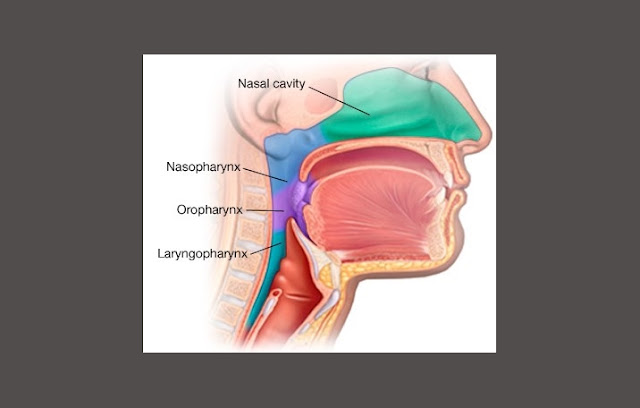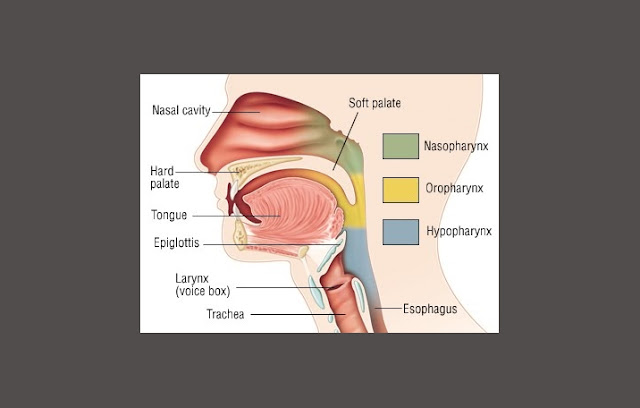A. UNDESTANDING THE DEFINITION OF PHARYNX
The pharynx is a cone-shaped tube that starts from
the back of the nose and oral cavity until the part before the trachea
(windpipe) and esophagus (the tube that connected to the stomach).
Pharyngeal part is narrowing from
beginning to end so it seems like a funnel that belongs to the part of the
respiratory system and also part of the digestive system. Pharynx word comes
from the Greek meaning throat. Pharynx generally have a length of about 12-15
cm.
B. THE FUNCTION OF PHARYNX
- Pharynx plays an important role in the respiratory system, digestive system, even in the process of speaking (sound).
- In the digestive system, pharynx acts as a conduit of food from the mouth to the esophagus. When food is being pushed by the tongue, then the airways will close and the food going into the esophagus.
- In the respiratory system, Pharynx acts as a filter, pressure regulator and also can regulate the incoming air humidity. This air is passed into the windpipe (trachea).
- Voice Sound processing, in this process, faring as an air entry path can play a significant role. The air must first pass through the pharynx and then the larynx, then the air is vibrating vocal cords so that we can talk.
- Pharynx can also adjust the air pressure in the ear. In the early part of the pharynx there is a channel that relate directly to the ear called the Eustachian tube. Well this channel serves to regulate the air pressure between the outside environment of the body with the environment in the ear.
C. THE STRUCTURE OF PHARYNX
Pharyngeal wall composed by 3 main layers,
namely:
- Mucous Layer, is strong and elastic, on this layer there is epithelium which has a mucus-secreting goblet cells. Mucus serves to protect the walls of the pharynx.
- Fibrous layer, a strong tissue and slightly elastic. This tissue is composed by collagen fibers.
- Muscular layer (muscles), there are 2 types uf muscles ; a circular muscle and longitudinal muscle. Combination of the contraction of these muscles will move the food to the next digestive organs.
D. PARTS OF PHARYNX
1. Nasopharynxl
Nasopharynx is part of the pharynx that lies at the
back of the nasal cavity. Nasopharynx is the part of which is only accessible to
air (food cannot enter), other parts of the pharynx can be traversed by air or
food. Nasopharynx derived from two words “naso” meaning nose and “pharynx”
means throat, therefore, this part also known as the connection of Nose and Throat.
Nasopharynx length of ranging between
2-4 cm. At the nasopharynx are two other important structures, namely:
- Eustachian tube, a structure that connects the middle ear to the nasopharynx. Eustachian tube function is to adjust the air pressure between the outside environment with inside parts of the ear. This tube will only open when swallowing, sneezing, yawning, or moving the jaw in a certain position. 1/3 parts of this tube is bone, while the other 2/3 is cartilage (soft).
- Adenoid (pharyngeal) Tonsil, a lobulated mass in the form of lymphoid tissue located in the roof of the mouth. Adenoid serves to fight harmful bacteria or organisms that enter through the nose and mouth, this section can also produce antibodies to fight infection.
2. oropharynx
Oropharynx is part of the pharynx which lies behind
the oral cavity. Oropharynx can be passed by air and food , therefore this part
plays a role in the respiratory system and digestive system. Oropharynx have a
valve that controls the food from entering the respiratory tract, this valve is
called the epiglottis. The valve can close the respiratory tract (then opening
of the digestive tract) when swallowing food and open the respiratory tract (GI
tract closed) during the process of breathing. On the lateral wall (left and
right), it contained palatine tonsils which are the mass of lymphatic tissue
that serves to fight infection.
3. laryngopharynx
laryngopharynx is the last part of the pharynx. This
section can also be bypassed by air and food. laryngopharynx composed by
stratified squamous epithelial cells. laryngopharynx also known as hypopharynx.
laryngopharynx is the meeting place between the respiratory tract and the
gastrointestinal tract. When we eat, the foods have "right of way" so
that the breathing tract would be close, therefore we are not able to swallow
while breath.




